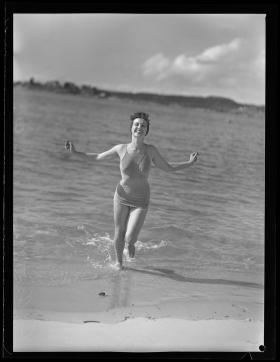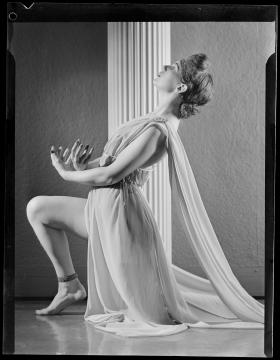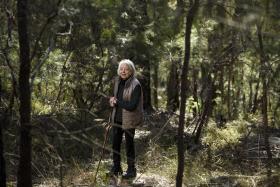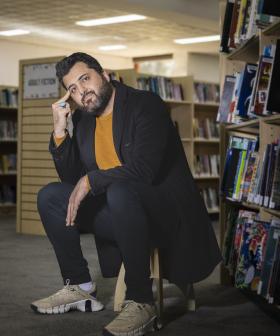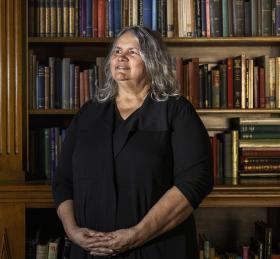Writer Charmian Clift was born 100 years ago. She died tragically young, but her work is in print, a documentary about her is being made, and her bohemian Greek island life is part of a forthcoming television series.
What might she have thought of cancel culture? Would she have identified as — or ed of — being ‘woke’? Would she have entered the fray on gender issues? Been active on social media? We will never know, but my bet is that had Charmian Clift been alive today, she would have been thrilled by progress on some issues and dismayed, if not to say appalled, by others. And she would have been vocal about it.
Charmian Clift was born 100 years ago, in August 1923 in Kiama, NSW. The worker’s cottage she grew up in still stands near Bombo Beach, where a reserve bears her name. But she was always destined for a bigger canvas than that sleepy coastal community could offer.
It was her physical beauty that first got her noticed, when she won a Beach Girl contest in 1941 and became a bathing suit pin-up and cover girl, glowing with natural athleticism and vitality.
Her perceptive biographer, Nadia Wheatley, writes about her subject with unsentimental empathy and high regard in her 2001 book The Life and Myth of Charmian Clift. The biography provides cultural context for her way of life and strips away the layers of myth that have wrapped Clift in veils of romantic misinterpretation.
Of Clift’s youth, Wheatley writes: ‘After being applauded as a child for being clever rather than pretty, it was an extraordinary experience for the “little speckled thrushy” (as she identified herself) to be acknowledged as a swan overnight. Charmian quickly adapted to the role of beauty queen, little realising that the trade-off would be the devaluing of her intelligence. From then on, many people would regard her solely for her outward self.’
After a period in the Australian Women’s Army Service, Clift joined the Melbourne Argus newspaper where she met one of its luminaries, George Johnston. The couple married in 1947 and had two children, Martin and Shane, before moving to London. They collaborated on a novel — which Johnston credited largely to his wife — High Valley, based on Johnston’s wartime journey through the mountains of Tibet.
Over the next few years, Clift reinvented herself. A free spirit, at ease in her own body, she ripened into a new, liberated kind of woman. In her daily life — as on the page — she was ahead of her time, a rebel who cared nothing for convention. Perhaps that spirit is what makes her enduringly attractive to successive generations. We envy her capacity to live on her own terms and we all want the formula, the secret sauce: how did she do it?
All that liberation came with a high price, however, both creatively and personally. She died of an overdose of barbiturates in 1969 at the age of 46, just ahead of the publication of her husband George Johnston’s novel Clean Straw for Nothing. Some said she was worried that his novel would expose her infidelities. Or perhaps she was past caring.
When Clift, Johnston and their two children moved in the 1950s to the Greek island of Hydra, after a year on Kalymnos, they found themselves at the epicentre of a creative crowd that included Leonard Cohen and other passing minstrels, poets and wannabes. Their lives were frugal but rich, messy and intoxicated, productive and destructive. Paradise, sometimes, but hell too. Adults and children ran wild.
In Greece, Clift wrote her two distinctive memoirs, Mermaid Singing and Peel Me a Lotus, as well as a novel, Honour’s Mimic and, together with Johnston, The Sponge Divers. He, meanwhile, was also at work on what would become his Miles Franklin award-winning novel, My Brother Jack. They were industrious as well as social, prolific as well as hedonistic.
In all her writing, but most especially her essays, Clift’s voice reads today as freshly minted, bell- like in its clarity. Her hugely popular columns for the Sydney Morning Herald, all 240 of them, were written in the last four years of her life for readers she referred to as her ‘Thursday ladies’. She referred to her pieces as ‘sneaky little revolutions’, the title under which they were anthologised in 2022. They demonstrate her remarkable gift for economy with words and writing with equal flair whether her subject is frivolous or serious — from how to choose a hat for the races to the impact of migration policy. Her words feel modern and timeless, as classic and classless as a pair of jeans.
For her own generation of readers, Clift represented escape: she ran away from everything that was safe and predictable to a Mediterranean existence that epitomised bohemian, creative glamour. In Greece she lived on next to nothing, basking in sunshine and sensuality, surrounded by a seemingly endless source of stimulating and seductive neighbours and visitors.
But the island idyll came to an end. The family returned to Sydney due to Johnston’s health — he suffered badly from tuberculosis — in 1964. The family settled in Mosman, hardly the epicentre of counterculture. Perhaps a sense of being stuck in a suburb that did not match her sensibility or values made coming home harder than she expected. She admitted she felt ‘both native-born and half-alien …’, comparing the experience of returning from ‘a nomadic tribe to a strange new encampment’ but adding, with characteristic optimism ‘what is fresh and new and exhilarating … is that for the first time I know that I actually belong here.’
On several occasions she wrote columns in which she prodded gently at cultural sore spots, asking whether Australia had changed in her absence as much as some claimed. She demonstrated that she was ahead of her time when it came to politics, raising her concern about Australia’s growing involvement in Vietnam, for example, in an article titled ‘On a Lowering Sky in the East’. Her friendship with civil rights activist Faith Bandler prompted her to urge readers to vote Yes in the 1967 referendum to amend the Constitution so that Aboriginal and Torres Strait Islanders were counted as part of the population. In another essay, she suggested that an apology to First Nations peoples was long overdue.
Clift was a feminist, declaring her independence of thought and action at every turn. In a piece called ‘Second Class Citizens’, she called out what she saw as ‘sexual apartheid in employment, wages, social standing and moral judgements’. She also raged against middle age, calling it ‘a rather nasty joke… there is very little that is consolatory about it.’
Her influence on subsequent generations writers persists. British novelist Polly chose to make Charmian a central character in her 2020 novel A Theatre for Dreamers, where she was a social kind of earthmother and writer, exploring creativity and free love in her telling of the Hydra years.
Nearly 20 years earlier, Australian journalist and novelist Susan Johnson wrote The Broken Book as a fictional tribute to Clift. It focused on the difficulties of juggling work and motherhood, and the guilt and shame that Clift endured as a result of giving away her illegitimate first child, Suzanne Chick, who subsequently wrote a memoir called Searching for Charmian, published in 1994. (In a further delicious twist, Chick’s own daughter Gina Chick recently won the SBS reality TV survival show Alone Australia. Viewers were captivated by her handsome features, eloquence and ease in the natural world. It’s tempting to think of these qualities as an inheritance from the grandmother she never knew.)
From her early days as a journalist, from when she first read her file of clippings at the Sydney Morning Herald, writer Susan Johnson was haunted by Clift. She told me, ‘I photocopied much of that file and carried the clippings around with me from house to house, country to country, for years. There was something about her story which caught me. I don’t think she was an especially good novelist, but I think she was of the finest order of essayist and memoirist, capable of turning ordinary life into the miraculous, of turning the prosaic into poetry.
‘I think it’s her ability to capture wonder, the elusive, nuanced, shrouded mysteries of existence, of being alive, a visceral corporeal experience, but at the same time a metaphysical one only occasionally revealed to us as wondrous. She captures — like no other writer — those moments in life when we glimpse its beauties and enchantments, when the full wonder of being alive and breathing is suddenly known to us. I love her for that.’
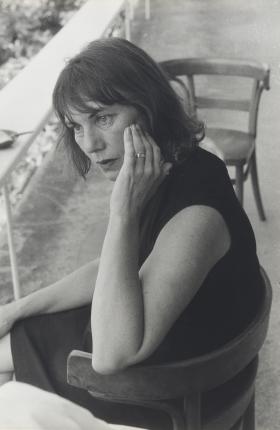
Johnson adds, ‘Because her work is so joyous (she does avoid darkness) it will always have readers. The first translation into Greek this year of Mermaid Singing is probably only the start. It means another generation will discover the many joys of her work. However, I would add that both Clift and Johnston and many of their artist friends left Australia partly because of its lack of appreciation of the arts. But before she died in 1969, Clift was hopeful that the old Australia was becoming a place of artistic self-creation and vision. I believe in 2023 that’s only partly true. In this year, the centenary of her birth, a documentary about her is struggling to find a home, which is a shame.’
Quite. Veteran award-winning film producer Sue Milliken and director Rachel Lane have spent four years making Life Burns High, a phrase borrowed from Peel Me a Lotus. They hope to complete the film by the end of Clift’s centenary year, subject to finding the funds and a broadcaster willing to screen it.
During this production period, they have assembled riveting archival material from sources including the State Library of NSW. They have insightful testimonies from a hefty cast of people who knew Clift well, including fellow writer Rodney Hall, who lived on Hydra at the same time as the Johnstons but who sadly lost all his photos of that era in a bushfire. Further commentary comes from fellow writer and friend Tom Keneally and publisher Richard Walsh.
‘It was Nadia Wheatley’s biography that first got me interested,’ remembers Lane, who went on to option the rights to the book, thinking initially it might provide the material for a feature film or television drama. ‘But I soon realised how expensive that would be because of locations and period, so I switched to documentary, little realising what a challenge that would prove to be.’
Milliken remembers meeting Clift early in her career while working as a production assistant at the ABC, where both Clift and Johnston were working on a documentary about their friends Sidney and Cynthia Nolan. ‘I can see her now,’ remembers Milliken ‘She was so vibrant and direct and charismatic. And she had the greenest eyes I have ever seen. George got all the kudos, but she was so capable and talented. I remember having a drink with her once after work and she said, “Everyone says ‘poor George’ because of his health, but no one ever says ‘poor Charmian’.”’ She was holding the family together. I do think there was rivalry between them and that they led complicated lives.’
Only one of the three children Charmian had while married to George is still alive. Tragically, like her mother, their daughter Shane committed suicide and their son Martin died of alcoholism-related illness. Their youngest son, Jason, the only one born on Hydra, declined to be interviewed for the film. He has always kept his distance from the mythologising of his parents but retains copyright on much of the material in the documentary.
‘The parents were a time bomb,’ says Lane, whose film features a tellingly awkward exchange between the parents and children, self-consciously lined up for an interview that shows the youngsters torn between two worlds and two languages.
Wheatley contends, with compelling evidence, that Clift’s end was an intoxicated cry for help rather than a deliberate decision to end her life. Reading between the lines of Sneaky Little Revolutions, edited by Wheatley, Clift sounds like the kind of expansive if untidy parent who would have made room at the table for any unexpected school friend her children brought home and been genuinely interested in what they had to say. A ‘fun’ mother who perhaps valued spontaneity over routine.
But eventually, the pressures of uncertain finances, the heavy drinking, and the increasingly fraught creative partnership took their toll. Clift was juggling one ball too many. What might she have accomplished had she lived? Milliken said her first attempt at adapting Johnston’s My Brother Jack for television was excellent, so perhaps she might have found a new avenue as a screenwriter. We’ll never know.
Fascination with the Hydra years continues. A Norwegian–Canadian TV co-production, So Long Marianne, about the relationship between Leonard Cohen and his muse, Marianne Ihlen, has cast Australian actress Anna Torv as Charmian Clift and the suitably lean Noah Taylor as George Johnston. (Somewhat disconcertingly, Scandi crime writer Jo Nesbo is credited as one of the screenwriters.) So, we are due for a dramatised layer of interpretation of Clift, the Greek island domestic goddess.
When she returned to Australia, Clift described what she called a ‘feeling of imminence here’ and hoped that might result in a creative renaissance of Australians telling Australian stories in film, literature, art and performance. She might be pleased to know that hope has borne abundant fruit.
Caroline Baum is the presenter of Life Sentences, a podcast about contemporary biography.
This story appears in Openbook spring 2023.

